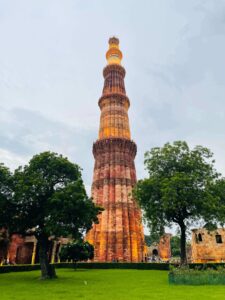Qutab Minar
Qutub Minar is a towering structure located in Delhi, India. Rising gracefully to a height of approximately 73 meters (240 feet), it stands as a remarkable example of medieval Indo-Islamic architecture. Constructed in the 12th century by Qutub-ud-din Aibak and later completed by Iltutmish, the minaret is made of red sandstone and adorned with intricate carvings and inscriptions. Its five distinct stories showcase a blend of Indo-Islamic and Persian architectural styles. Qutub Minar forms part of the Qutub Complex, which also includes the Quwwat-ul-Islam Mosque, the Iron Pillar of Delhi, and other historical structures. Designated as a UNESCO World Heritage Site, Qutub Minar remains a significant symbol of Delhi’s rich historical and cultural legacy, attracting visitors from around the world.
Rashtrapati Bhavan
Rashtrapati Bhavan, located in New Delhi, India, is the official residence of the President of India. Spread over a vast area, it stands as an architectural masterpiece, blending various styles, including classical, Mughal, and European influences. Designed by Sir Edwin Lutyens, the building features a grand and imposing structure with intricate detailing and extensive use of red and cream sandstone. The central dome, adorned with the Ashokan Chakra, is a prominent element of its design. Rashtrapati Bhavan houses multiple rooms and halls, serving as the ceremonial and administrative hub for the President’s activities. The beautifully landscaped Mughal Gardens surrounding the Bhavan add to its charm. As an iconic symbol of India’s democratic governance, Rashtrapati Bhavan holds historical and cultural significance and is a must-visit landmark for tourists and citizens alike.








